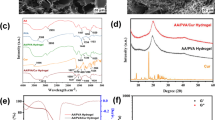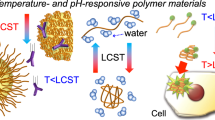Abstract
The significant developments in the field of polymer have advanced the synthesis of polymer-based materials and have expanded their use in a wide variety of applications. Today, polymers can be designed to change their properties in response to a single stimulus or multiple stimuli. Such types of polymers are called stimuli-sensitive or stimuli-responsive polymers, and have been utilized for controlled release in the field of biomedicine. Herein, we report the use of alginate (SA) based graft copolymer with poly(N-isopropylacrylamide) (PIPAAm) and poly(acrylic acid) (PAA) to synthesize dual stimuli-sensitive beads via microwave-assisted graft copolymerization method for controlled release of indomethacin (IND). It is demonstrated that the polymer beads composed of SA-g-PIPAAm/PAA are sensitive to pH and temperature. The structure of successfully prepared stimuli-sensitive beads by cross-linking via glutaraldehyde is characterized by FTIR, X-RD and SEM analysis.









Similar content being viewed by others
References
Wandera D, Wickramasinghe SR, Husson SM (2010) Stimuli-responsive membranes. J Membr Sci 357:6–35
Babu VR, Rao KSVK, Sairam M, Naidu BVK, Hosamani KM, Aminabhavi TM (2006) pH-Sensitive interpenetrating network microgels of sodium alginate-acrylic acid for the controlled release of ibuprofen. J Appl Polym Sci 99:2671–2678
Chan G, Mooney DJ (2008) New materials for tissue engineering: towards greater control over the biological response. Trends Biotechnol 26:382–392
Hoffmann J, Plotner M, Kuckling D, Fischer WJ (1999) Photopatterning of thermally sensitive hydrogels useful for microactuators. Sens Actuat A Phys 77:139–144
Fleige E, Quadir MA, Haag R (2012) Stimuli-responsive polymeric nanocarriers for the controlled transport of active compounds: concepts and applications. Adv Drug Deliv Rev 64:866–884
Don T-M, Chen H-R (2005) Synthesis and characterization of AB-crosslinked graft copolymers based on maleilated chitosan and N-isopropylacrylamide. Carbohydr Polym 61:334–347
Zhang L, Wang L, Guo B, Ma PX (2014) Cytocompatible injectable carboxymethyl chitosan/N-isopropylacrylamide hydrogels for localized drug delivery. Carbohydr Polym 103:110–118
Lee H, Peietrasik J, Sheiko SS, Matyjaszewski K (2010) Stimuli-responsive molecular brushes. Prog Polym Sci 35:24–44
Schmaljohann D (2006) Thermo- and pH-responsive polymers in drug delivery. Adv Drug Deliv Rev 65(4):497–514
Chan A, Orme RP, Fricker RA, Roach P (2013) Remote and local control of stimuli responsive materials for therapeutic applications. Adv Drug Deliv Rev 58:1655–1670
Curcio M, Spizzirri UG, Iemma F, Puoci F, Cirillo G, Parisi OI, Picci N (2010) Grafted thermo-responsive gelatin microspheres as delivery systems in triggered drug release. Eur J Pharm Biopharm 76:48–55
Pawar SN, Edgar KJ (2012) Alginate derivatization: a review of chemistry, properties and applications. Biomaterials 33:3279–3305
Yiğitoğlu M, Aydın G, Işıklan N (2014) Microwave-assisted synthesize of alginate-g-polyvinylpyrrolidone and its application in controlled release. Polym Bull 71:385–414
Lee KY, Mooney D (2012) Alginate: properties and biomedical applications. Prog Polym Sci 37(1):106–126
Sun J, Tan H (2013) Alginate-based biomaterials for regenerative medicine applications. Materials 6:1285–1309
Işıklan N, Küçükbalcı G (2012) Microwave-induced synthesis of alginate-graft-poly(N-isopropylacrylamide) and drug release properties of dual pH- and temperature-responsive beads. Eur J Pharm Biopharm 82:316–331
Işıklan N, İnal M, Kurşun F, Ercan G (2011) pH responsive itaconic acid grafted alginate microspheres for the controlled release of nifedipine. Carbohydr Polym 84:933–943
Abou el Ela AESF, Hassan MA, El- Maraghy DA (2014) Ketorolac tromethamine floating beads for oral application: characterization and in vitro/in vivo evaluation. Saudi Pharm J 22:349–359
Işıklan N, İnal M, Yiğitoğlu M (2008) Synthesis and characterization of poly(N-vinyl-2-pyrrolidone) grafted sodium alginate hydrogel beads for the controlled release of indomethacin. J Appl Polym Sci 110:481–493
Peppas NA (1985) Analysis of Fickian and non-Fickian drug release from polymer. Pharm Acta Helv 60:110–111
Mishra S, Sen G (2011) Microwave initiated synthesis of polymethylmethacrylate grafted guar (GG-g-PMMA), characterizations and applications. Int J Biol Macromol 49:591–598
Işıklan N, Kurşun F, İnal M (2010) Graft copolymerization of itaconic acid onto sodium alginate using benzoyl peroxide. Carbohydr Polym 79:665–672
Hua S, Ma H, Li X, Yang H, Wang A (2010) pH-Sensitive sodium alginate/poly(vinyl alcohol) hydrogel beads prepared by combined Ca2+ crosslinking and freeze-thawing cycles for controlled release of diclofenac sodium. Int J Biol Macromol 4:517–523
Wang NFQ, Li P, Zhang JP, Wang AQ, Wei Q (2010) A novel pH-sensitive magnetic alginate-chitosan beads for albendazole delivery. Drug Dev Ind Pharm 36:867–877
Yua S, Lüa Z, Chen Z, Liu X, Liu M, Gao C (2011) Surface modification of thin-film composite polyamide reverse osmosis membranes by coating N-isopropylacrylamide-co-acrylic acid copolymers for improved membrane properties. J Membr Sci 371:293–306
Beattie DA, Addai-Mensah J, Beaussart A, Franks GV, Yeap K-Y (2014) In situ particle film ATR FTIR spectroscopy of poly(N-isopropyl acrylamide) (PNIPAM) adsorption onto talc. Phys Chem Chem Phys 16:25143–25151
Katsumoto Y, Tanaka T, Sato H, Ozaki Y (2002) Conformational change of poly(N-isopropylacrylamide) during the coil-globule transition investigated by attenuated total reflection/infrared spectroscopy and density functional theory calculation. J Phys Chem A 106:3429–3435
Ahmed Z, Gooding EA, Pimenov KV, Wang L, Asher SA (2009) UV resonance raman determination of molecular mechanism of poly(N-isopropylacrylamide) volume phase transition. J Phys Chem B 113(13):4248–4256
Smitha B, Sridhar S, Khan AA (2005) Chitosan–sodium alginate polyion complexes as fuel cell membranes. Eur Polym J 41:1859–1866
Murillo-Álvarez JI, Hernández-Carmona G (2007) Monomer composition and sequence of sodium alginate extracted at pilot plant scale from three commercially important seaweeds from Mexico. J Appl Phycol 19:545–548
Kaur I, Kumar R, Sharma N (2010) A comparative study on the graft copolymerization of acrylic acid onto rayon fiber by a ceric ion redox system and a γ-radiation method. Carbohydr Res 345:2164–2173
O’Brien M, McCauley J, Cohen E (1984) Indomethacin. In: Florey K (ed) Analytical profiles of drug substances, vol 13. Academic Press, New York, pp 222–227
Panigrahy RN, Chinnala KM (2014) Formulation and evaluation of indomethacin solid dispersion by using hydrophilic polymers. Int J Pharm Res Health Sci 2(1):87–95
Gonga K, Rehmanb IU, Darra JA (2008) Characterization and drug release investigation of amorphous drug–hydroxypropyl methylcellulose composites made via supercritical carbon dioxide assisted impregnation. J Pharm Biomed Anal 48:1112–1119
Ramesh Babu V, Sairam M, Hosamani KM, Aminabhavi TM (2006) Preparation and characterization of novel semi-interpenetrating 2-hydroxyethyl methacrylate-g-chitosan copolymeric microspheres for sustained release of indomethacin. J Appl Polym Sci 106:3778–3785
Thakur A, Wanchoo RK, Singh P (2011) Hydrogels of poly(acrylamide-co-acrylic acid): in-vitro study on release of gentamicin sulfate. Chem Biochem Eng Q 25(4):471–482
Agnihotri SA, Aminabhavi TM (2006) Novel interpenetrating network chitosan-poly (ethylene oxide-g-acrylamide) hydrogel microspheres for the controlled release of capecitabine. Int J Pharm 324(2):103–115
Shi J, Zhang Z, Qi W, Cao S (2012) Hydrophobically modified biomineralized polysaccharide alginate membrane for sustained smart drug delivery. Int J Biol Macromol 50:747–753
Reddy KM, Babu VR, Rao KSVK, Subha MCS, Rao KC, Sairam M, Aminabhavi TM (2008) Temperature sensitive semi-IPN microspheres from sodium alginate and N-isopropylacrylamide for controlled release of 5-fluorouracil. J Appl Polym Sci 107:2820–2829
Temtem M, Barroso T, Casimiro T, Mano JF, Aguiar-Ricardo A (2012) Dual stimuli responsive poly(N-isopropylacrylamide) coated chitosan scaffolds for controlled release prepared from a non residue technology. J Supercrit Fluids 66:398–404
Dadsetan M, Taylor KE, Yong C, Bajzer Z, Lu L, Yaszemski MJ (2013) Controlled release of doxorubicin from pH-responsive microgels. Acta Biomater 9(3):5438–5446
Ritger PL, Peppas NA (1987) A simple equation for description of solute release II Fickian and anomalous release from swellable devices. J Control Release 5:37–42
Acknowledgments
The authors are grateful to the Kirikkale University for financial support with the project number of 2011/07.
Author information
Authors and Affiliations
Corresponding author
Ethics declarations
Conflict of interest
The authors report no conflicts of interest. The authors alone are responsible for the content and writing of the paper.
Rights and permissions
About this article
Cite this article
Işıklan, N., Küçükbalcı, G. Synthesis and characterization of pH- and temperature-sensitive materials based on alginate and poly(N-isopropylacrylamide/acrylic acid) for drug delivery. Polym. Bull. 73, 1321–1342 (2016). https://doi.org/10.1007/s00289-015-1550-x
Received:
Revised:
Accepted:
Published:
Issue Date:
DOI: https://doi.org/10.1007/s00289-015-1550-x




